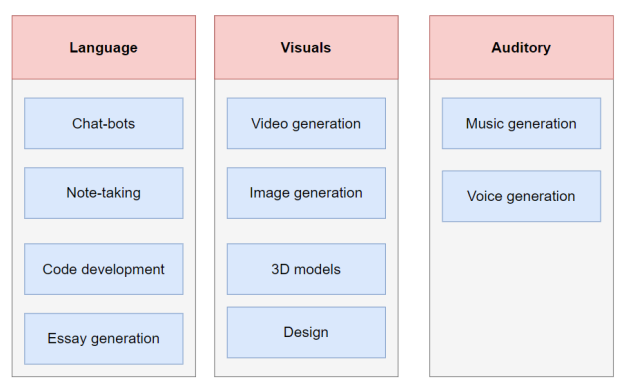I am very much interested in AI to learn and apply as a programmer. So now I want to learn the types of AI. That’s why today I have started to learn the very basics things of AI, some of the fundamental types of AI:
Artificial Intelligence is a broad field with various subfields and types. Here are some of the fundamental types of AI:
- Narrow or Weak AI (Artificial Narrow Intelligence – ANI): This type of AI is designed for a specific task or a narrow range of tasks. It operates under a predefined set of rules and does not possess general intelligence or consciousness. Examples include virtual personal assistants like Siri or Alexa, recommendation systems, and chatbots.
- General AI (Artificial General Intelligence – AGI): AGI is a theoretical form of AI that possesses human-like intelligence. It can understand, learn, and apply knowledge across a wide range of tasks, just like a human. Achieving AGI is a long-term goal of AI research, and it doesn’t currently exist.
- Superintelligent AI: This is a hypothetical AI that surpasses human intelligence in every aspect. It’s often portrayed in science fiction and remains a topic of debate and speculation among AI researchers and ethicists.
- Machine Learning (ML): Machine learning is a subset of AI that focuses on developing algorithms and models that enable computers to learn and make predictions or decisions from data. It includes supervised learning, unsupervised learning, and reinforcement learning.
- Deep Learning: Deep learning is a subfield of machine learning that uses artificial neural networks inspired by the structure and function of the human brain. It’s particularly effective for tasks involving large datasets and has been used in image and speech recognition, natural language processing, and more.
- Reinforcement Learning: This type of learning is inspired by behavioral psychology and focuses on training AI agents to make sequential decisions by rewarding or punishing them based on their actions. It’s commonly used in game playing, robotics, and autonomous systems.
- Natural Language Processing (NLP): NLP is a branch of AI that deals with the interaction between computers and human language. It enables machines to understand, interpret, and generate human language, making it crucial for applications like chatbots, language translation, and sentiment analysis.
- Computer Vision: Computer vision involves teaching machines to interpret and understand visual information from the world, such as images and videos. Applications include image recognition, object detection, and autonomous vehicles.
- Expert Systems: Expert systems are AI programs designed to mimic the decision-making abilities of a human expert in a specific domain. They use rule-based reasoning and knowledge representation to provide solutions to complex problems.
- Robotics: AI plays a significant role in robotics, enabling robots to perceive their environment, make decisions, and perform tasks autonomously. This includes industrial robots, drones, and humanoid robots.
- Cognitive Computing: Cognitive computing combines AI techniques, natural language processing, and other technologies to simulate human thought processes. IBM’s Watson is a well-known example used in various fields, including healthcare and finance.
- Autonomous Systems: These are AI-powered systems that can operate independently without human intervention. Examples include autonomous cars, drones, and smart home devices.
As you delve deeper into AI, you can explore these different types and their respective applications. It’s essential to start with the basics and gradually build your knowledge and skills in the specific areas that interest you the most. There are numerous online courses, tutorials, and books available to help you get started with AI programming and development.
GPT (Generative Pretrained Transformer) is a language model developed by OpenAI, which has taken the world of natural language processing (NLP) by storm.
That’s why a peep has come to mind that Chat GPT is a generative AI type. Actually, generative AI is not a distinct type of AI like narrow AI or deep learning but rather a category of AI techniques and models used to generate data, content, or other outputs. Generative AI systems create new data samples, such as images, text, or even music, based on patterns and information learned from existing data.
Some common examples of generative AI techniques include:
- Generative Adversarial Networks (GANs): GANs consist of two neural networks, a generator, and a discriminator, that are trained in a competitive manner. The generator tries to create data samples that are indistinguishable from real data, while the discriminator tries to tell the difference between real and generated data. This competition results in the generation of realistic data.
- Variational Autoencoders (VAEs): VAEs are a type of neural network architecture used for data generation and dimensionality reduction. They are often employed in generating images or encoding and decoding data in a continuous latent space.
- Recurrent Neural Networks (RNNs) and Transformers: These are used in natural language generation tasks. RNNs can generate sequences of text or other data, while Transformers are especially powerful in tasks like language translation and text generation.
- Autoregressive Models: These models generate data one element at a time, conditioning each element on the previously generated ones. Examples include autoregressive language models like GPT (Generative Pre-trained Transformer) and autoregressive generative models like PixelCNN for image generation.
- Markov Models: These models use the Markov property to generate sequences of data based on probabilistic transitions between states. Hidden Markov Models (HMMs) are an example used in speech recognition and bioinformatics.
Generative AI has a wide range of applications, from generating realistic images and text to creating music and even designing novel molecules for drug discovery. While generative AI techniques are incredibly powerful, they also come with ethical considerations, such as the potential for generating fake content or infringing on copyrights.
In summary, generative AI refers to the subset of AI techniques and models that are used to create new data or content, and it encompasses various methods and approaches within the field of artificial intelligence.
So what is Generative AI?
Generative AI, short for Generative Artificial Intelligence, is a subset of artificial intelligence that focuses on creating machines capable of generating content that is similar to what a human might produce. In other words, it involves AI systems that can generate new data, such as text, images, audio, or even video, often by learning from existing data.
The key characteristic of generative AI is its ability to produce novel content rather than just making decisions or predictions based on existing data. It involves modeling complex patterns and relationships within data to generate new, meaningful, and often creative outputs. Generative AI techniques often rely on deep learning and neural networks to achieve this capability.
Here are some common applications and examples of generative AI:
- Text Generation: AI models like GPT (Generative Pre-trained Transformer) can generate coherent and contextually relevant text. They are used in chatbots, content generation, and even creative writing.
- Image Generation: Generative Adversarial Networks (GANs) are widely used to create realistic images that may not exist in reality. These can be applied in art, design, and even generating realistic faces of people who don’t exist.
- Music Composition: AI systems can generate music compositions based on input data, style, or preferences, which is useful in the music industry for creating background tracks or even entirely new pieces of music.
- Data Augmentation: Generative AI can be used to augment datasets by generating additional data points, which is valuable in machine learning for improving model training.
- Drug Discovery: In the field of pharmaceuticals, generative AI is used to design and suggest new molecules with potential therapeutic properties.
- Game Content: Game developers use generative AI to create game levels, characters, and content dynamically, enhancing gameplay experiences.
- Language Translation: Some AI models are capable of generating translations for languages even if they were not explicitly trained on that language pair.
Generative AI has made significant advancements in recent years, thanks to deep learning techniques and the availability of large datasets. It has the potential to automate and enhance creative and content generation tasks across various industries, making it a fascinating and rapidly evolving field within artificial intelligence. However, it also raises ethical concerns, such as the potential for generating misleading or harmful content, which must be carefully considered and addressed.

Sayed is a Backend Python Programmer at sayed.xyz with 1+ years of experience in tech. He is passionate about helping people become better coders and climbing the ranks in their careers, as well as his own, through continued learning of leadership techniques and software best practices.
